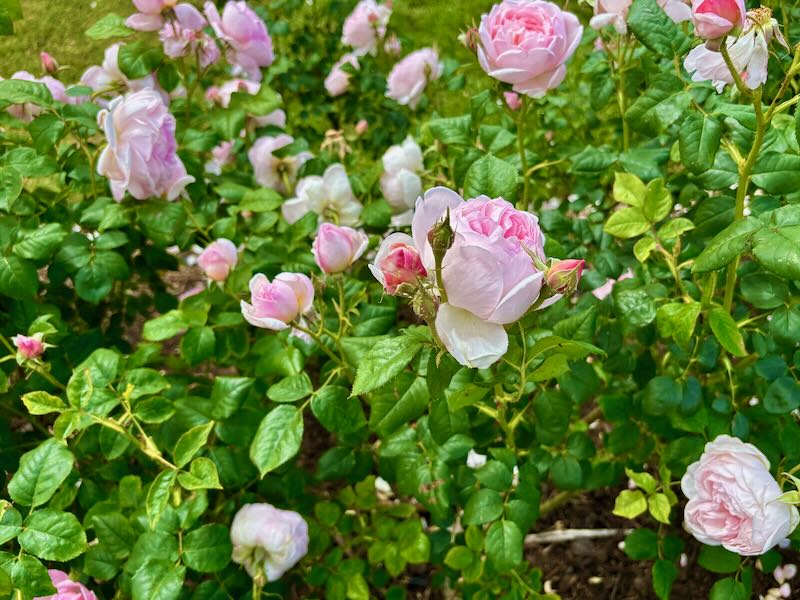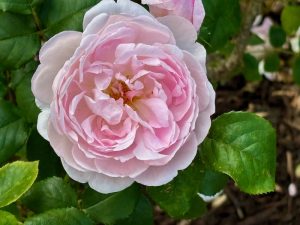Rosa ‘Scepter’d Isle®’ – A Myrrh-Scented English Rose with Graceful Charm
Rosa ‘Scepter’d Isle®’ is an elegant English Shrub Rose bred by David Austin. Known for its shell-pink chalice blooms and powerful myrrh fragrance, this rose embodies the perfect blend of beauty and character. Its flowers are delicate yet plentiful, held elegantly above semi-glossy dark green foliage. Introduced in 1996, it remains one of the most admired roses in Austin’s collection, valued for its fragrance, repeat flowering, and upright form. The name comes from John of Gaunt’s famous speech in Shakespeare’s Richard II, a tribute to England’s “scepter’d isle.”
Background and Family
This rose belongs to the Rosaceae family, which includes familiar plants such as apples, plums, and strawberries. Within the genus Rosa, ‘Scepter’d Isle®’ is registered under the breeder code ‘AUSland’. It was developed by crossing an unnamed seedling with Rosa ‘Heritage’ (Ausblush), another well-loved English rose. David Austin’s goal was to combine the romance of old garden roses with the vigor and repeat flowering of modern varieties. The result is a rose that delivers on all counts: grace, perfume, and resilience.
Flowers and Foliage
The blooms of Rosa ‘Scepter’d Isle®’ are the centerpiece of the plant. Each medium-sized flower measures around 9–10 cm (3.5–4 in) across. They open as cupped chalices of soft pink, with the outer petals fading to a paler shade as they mature. At the heart of each bloom lies a cluster of golden stamens that stand out vividly against the lighter petals. When planted in groups, the effect is both romantic and refined. The fragrance is powerful and distinct, with the unmistakable myrrh scent that many gardeners associate with classic English roses. It has sweet, resinous notes reminiscent of honey and spice, creating a garden atmosphere rich in perfume.
The foliage complements the flowers beautifully. The leaves are dark green, slightly glossy, and oval in shape, forming a lush backdrop for the blooms. New growth appears tinged with red before maturing to deep green. The plant forms an upright, bushy shrub with well-spaced canes that hold the flowers above the foliage, giving the plant an elegant and balanced appearance.
Flowering Season of Rosa ‘Scepter’d Isle®’
This rose is a reliable and generous bloomer. Its first flush appears in late spring, followed by repeat flowering throughout summer and into autumn. In mild climates, it may continue producing blooms until the first frost. Each new flush of flowers brings renewed color and fragrance to the garden. The shrub grows to about 1.2–1.5 m (4–5 ft) tall and spreads 0.9–1.2 m (3–4 ft) wide. It forms a strong structure, upright and well-branched, making it suitable for borders, hedges, or as a standalone specimen.
Breeder and Heritage
Bred by David C. H. Austin, ‘Scepter’d Isle®’ was introduced in the United Kingdom in 1996. Austin’s roses are celebrated for their romantic appearance and refined fragrance, qualities that are perfectly captured in this variety. Its strong myrrh scent earned it the Royal National Rose Society’s Henry Edland Award for fragrance. Today, it remains one of the most fragrant roses in the Austin collection and a favorite among gardeners who value perfume as much as bloom form.
How to Grow Rosa ‘Scepter’d Isle®’
Light
Plant Rosa ‘Scepter’d Isle®’ in full sun for best flowering. It can tolerate light afternoon shade, particularly in hot regions where protection from intense sun will help preserve the color and petal texture. Morning sun is especially important as it dries dew from the leaves, reducing the risk of fungal diseases.
Soil
The rose thrives in fertile, well-drained soil with a pH between 6.0 and 7.0. Prepare the site by digging deeply and incorporating organic matter such as compost or well-rotted manure into the top 30 cm (12 in) of soil. This helps improve structure and water retention. In heavy clay, add grit or sand to aid drainage; in sandy soil, increase organic content to hold nutrients and moisture.
Watering
Water thoroughly and regularly, particularly during the first growing season. Established plants prefer deep watering once or twice a week rather than light, frequent watering. Aim to deliver around 10–12 liters (2.5–3 gallons) each time. Always water at the base to avoid wetting the foliage. Mulch the surrounding soil to keep roots cool and retain moisture. Avoid overwatering, as soggy soil can cause root rot.
Fertilizing
Feed your rose in early spring when new growth appears. Use a balanced rose fertilizer or an organic mix such as composted manure. Apply again after the first flush of blooms to encourage repeat flowering. During mid-summer, a light feeding will maintain health but avoid over-fertilizing late in the season, as this may promote tender growth vulnerable to frost. Roses respond well to organic matter, so top-dress with compost once or twice a year to improve the soil naturally.
Pruning Rosa ‘Scepter’d Isle®’
Prune in late winter or early spring, before new growth begins. Remove dead, damaged, or crossing stems, and shape the plant by cutting remaining canes back by about one-third. This encourages new shoots and improves air circulation. For established shrubs, maintain an open framework to reduce disease risk. During the flowering season, deadhead regularly by cutting just above the first set of five leaves. This practice promotes continual blooming throughout summer and autumn.
In regions with mild winters, light pruning in summer can help maintain shape and stimulate another flush of flowers. Avoid heavy pruning late in the year, as it may encourage tender growth that can be damaged by cold.
Propagation
Gardeners can propagate Rosa ‘Scepter’d Isle®’ from cuttings. Softwood cuttings taken in late spring or semi-hardwood cuttings in early summer tend to root successfully. Take 12–15 cm (5–6 in) cuttings from non-flowering stems, remove lower leaves, and dip the cut end in rooting hormone. Place the cuttings in a free-draining medium and keep them humid until roots develop. Rooted cuttings should be grown on in pots before transplanting to the garden. Always respect propagation rights for patented cultivars.
Pests and Diseases
This variety has good resistance to common rose diseases, but good garden hygiene is essential for maintaining its health. Black spot, powdery mildew, and rust can occur in damp or overcrowded conditions. To prevent these problems, ensure adequate spacing and airflow around the plant. Water early in the day and avoid wetting the leaves. Remove any fallen or diseased foliage immediately to prevent reinfection.
Aphids can appear on new shoots and buds. Wash them off with a strong jet of water or use insecticidal soap if necessary. Occasionally, rose slugs or sawfly larvae may feed on the leaves; handpick them or use an organic control. Keep the plant strong through balanced feeding and consistent watering—healthy roses are far less prone to attack.
Winter Care and Hardiness
Rosa ‘Scepter’d Isle®’ is hardy in USDA Zones 5–11. In colder areas, protect the plant during winter by mounding 20–30 cm (8–12 in) of soil or compost around the base after the first frost. Remove this mound gradually in spring as new growth begins. Container-grown roses can be overwintered in an unheated garage or sheltered area to prevent freezing. In warmer climates, the plant remains green longer into the season, flowering until frost arrives.
Landscape Uses for Rosa ‘Scepter’d Isle®’
Few roses combine fragrance and form as harmoniously as Rosa ‘Scepter’d Isle®’. Its upright yet bushy habit makes it perfect for mixed borders or as a single specimen. Use it where its fragrance can be appreciated—along a garden path, near a sitting area, or by a doorway. In a cottage garden, pair it with Nepeta, Lavandula, or Salvia for contrast and to attract pollinators. For a softer ground layer, underplant with hardy geraniums or low-growing campanulas. The rose also performs well as a flowering hedge or in a large container, provided it receives ample sun and moisture.
Environmental Tolerance
This rose adapts well to different garden environments. It performs best in full sun but tolerates partial shade. It prefers moderate humidity and benefits from good air circulation. Once established, it can withstand short dry periods, though consistent watering yields the best results. The variety’s good disease resistance makes it well-suited to both temperate and humid climates.
Care Through the Seasons
In early spring, prune and feed to prepare for new growth. As the first buds appear, water regularly and apply mulch. During summer, deadhead faded blooms and provide a light feed to promote repeat flowering. In autumn, allow the last flush to complete naturally, then reduce watering. In cold regions, protect the crown before frost. With each passing year, your shrub will mature into a fuller, more fragrant specimen.
A Rose Worth Planting
Plant Rosa ‘Scepter’d Isle®’ where you can enjoy its perfume and beauty up close. It offers elegance without excess, fragrance without fragility, and performance without fuss. With its pale pink blooms and honeyed scent, it captures the charm of an English garden in full bloom and stands as a lasting tribute to David Austin’s vision of a truly romantic rose.



